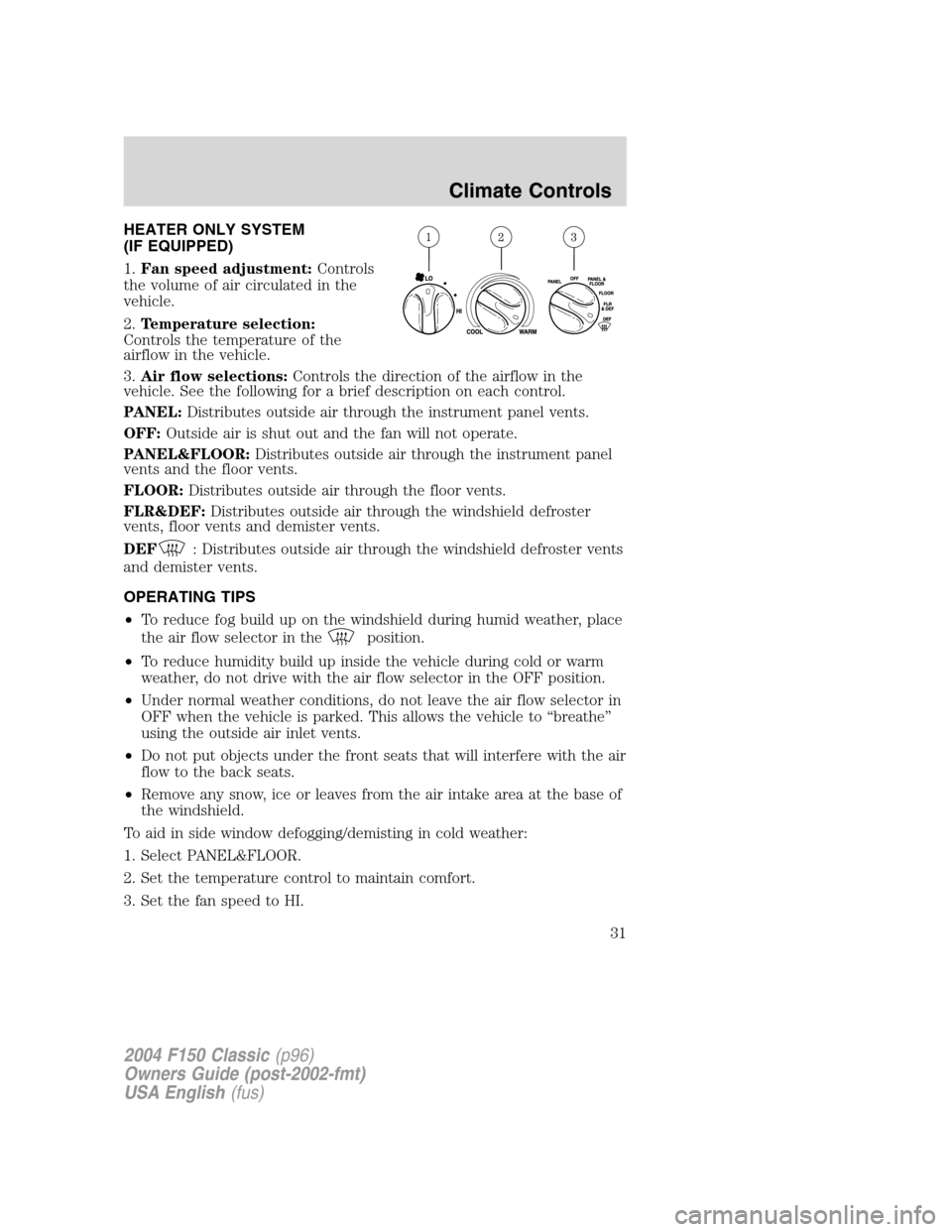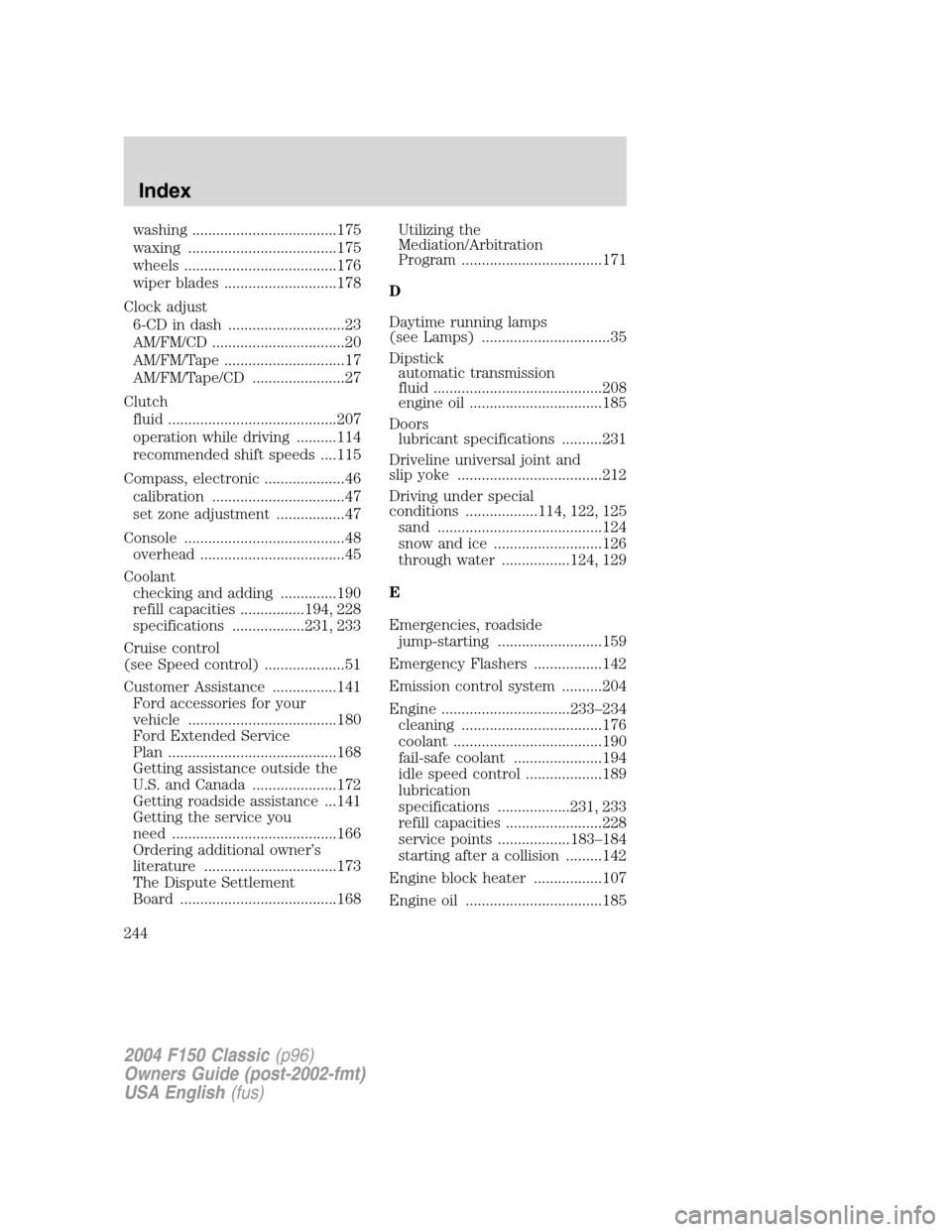2004 FORD F150 heater
[x] Cancel search: heaterPage 31 of 248

HEATER ONLY SYSTEM
(IF EQUIPPED)
1.Fan speed adjustment:Controls
the volume of air circulated in the
vehicle.
2.Temperature selection:
Controls the temperature of the
airflow in the vehicle.
3.Air flow selections:Controls the direction of the airflow in the
vehicle. See the following for a brief description on each control.
PANEL:Distributes outside air through the instrument panel vents.
OFF:Outside air is shut out and the fan will not operate.
PANEL&FLOOR:Distributes outside air through the instrument panel
vents and the floor vents.
FLOOR:Distributes outside air through the floor vents.
FLR&DEF:Distributes outside air through the windshield defroster
vents, floor vents and demister vents.
DEF
: Distributes outside air through the windshield defroster vents
and demister vents.
OPERATING TIPS
•To reduce fog build up on the windshield during humid weather, place
the air flow selector in the
position.
•To reduce humidity build up inside the vehicle during cold or warm
weather, do not drive with the air flow selector in the OFF position.
•Under normal weather conditions, do not leave the air flow selector in
OFF when the vehicle is parked. This allows the vehicle to“breathe”
using the outside air inlet vents.
•Do not put objects under the front seats that will interfere with the air
flow to the back seats.
•Remove any snow, ice or leaves from the air intake area at the base of
the windshield.
To aid in side window defogging/demisting in cold weather:
1. Select PANEL&FLOOR.
2. Set the temperature control to maintain comfort.
3. Set the fan speed to HI.
2004 F150 Classic(p96)
Owners Guide (post-2002-fmt)
USA English(fus)
Climate Controls
Climate Controls
31
Page 107 of 248

Starting the engine
1. Turn the key to 4 (ON) without
turning the key to 5 (START). If
there is difficulty in turning the key,
rotate the steering wheel until the
key turns freely.
2. Turn the key to 5 (START), then
release the key as soon as the
engine starts. Excessive cranking
could damage the starter.
Note:If the engine does not start within five seconds on the first try,
turn the key to OFF, wait 10 seconds and try again. If the engine still
fails to start, press the accelerator to the floor and try again; this will
allow the engine to crank with the fuel shut off in case the engine is
flooded with fuel.
Using the engine block heater (if equipped)
An engine block heater warms the engine coolant which aids in starting
and heater/defroster performance. Use of an engine block heater is
strongly recommended if you live in a region where temperatures reach
-10°F (-23°C) or below. For best results, plug the heater in at least three
hours before starting the vehicle. The heater can be plugged in the night
before starting the vehicle.
To reduce the risk of electrical shock, do not use your heater
with ungrounded electrical systems or two-pronged (cheater)
adapters.
Guarding against exhaust fumes
Carbon monoxide is present in exhaust fumes. Take precautions to avoid
its dangerous effects.
If you smell exhaust fumes inside your vehicle, have your dealer
inspect your vehicle immediately. Do not drive if you smell
exhaust fumes.
Important ventilating information
If the engine is idling while the vehicle is stopped for a long period of
time, open the windows at least one inch (2.5 cm) or adjust the heating
or air conditioning to bring in fresh air.
1
2
34
5
2004 F150 Classic(p96)
Owners Guide (post-2002-fmt)
USA English(fus)
Driving
107
Page 160 of 248

Preparing your vehicle
When the battery is disconnected or a new battery is installed, the
transmission must relearn its shift strategy. As a result, the transmission
may have firm and/or soft shifts. This operation is considered normal and
will not affect function or durability of the transmission. Over time, the
adaptive learning process will fully update transmission operation.
1.Use only a 12–volt supply to start your vehicle.
2. Do not disconnect the battery of the disabled vehicle as this could
damage the vehicle’s electrical system.
3. Park the booster vehicle close to the hood of the disabled vehicle
making sure the two vehiclesdo nottouch. Set the parking brake on
both vehicles and stay clear of the engine cooling fan and other moving
parts.
4. Check all battery terminals and remove any excessive corrosion before
you attach the battery cables. Ensure that vent caps are tight and level.
5. Turn the heater fan on in both vehicles to protect any electrical
surges. Turn all other accessories off.
Connecting the jumper cables
1. Connect the positive (+) jumper cable to the positive (+) terminal of
the discharged battery.
Note:In the illustrations,lightning boltsare used to designate the
assisting (boosting) battery.
+–+–
2004 F150 Classic(p96)
Owners Guide (post-2002-fmt)
USA English(fus)
Roadside Emergencies
160
Page 241 of 248

Splash guards
Step bars
Tonneau covers
Truck caps
Wheels
Interior style
Cell phone holders
Consoles
Electrochromatic compass/temperature interior mirrors
Floor mats
Interior trim kits
Leather wrapped steering wheels
Scuff plates
Speed control
Lifestyle
Bedliners and bedmats
Bed tents
Bike racks
Cargo organization and management
Diamond plate accessories
Engine block heaters and blankets
Rear seat entertainment systems
Toolboxes
Towing mirrors
TracRac and accessories
Trailer hitches, wiring harnesses and accessories
2004 F150 Classic(p96)
Owners Guide (post-2002-fmt)
USA English(fus)
Accessories
241
Page 244 of 248

washing ....................................175
waxing .....................................175
wheels ......................................176
wiper blades ............................178
Clock adjust
6-CD in dash .............................23
AM/FM/CD .................................20
AM/FM/Tape ..............................17
AM/FM/Tape/CD .......................27
Clutch
fluid ..........................................207
operation while driving ..........114
recommended shift speeds ....115
Compass, electronic ....................46
calibration .................................47
set zone adjustment .................47
Console ........................................48
overhead ....................................45
Coolant
checking and adding ..............190
refill capacities ................194, 228
specifications ..................231, 233
Cruise control
(see Speed control) ....................51
Customer Assistance ................141
Ford accessories for your
vehicle .....................................180
Ford Extended Service
Plan ..........................................168
Getting assistance outside the
U.S. and Canada .....................172
Getting roadside assistance ...141
Getting the service you
need .........................................166
Ordering additional owner’s
literature .................................173
The Dispute Settlement
Board .......................................168Utilizing the
Mediation/Arbitration
Program ...................................171
D
Daytime running lamps
(see Lamps) ................................35
Dipstick
automatic transmission
fluid ..........................................208
engine oil .................................185
Doors
lubricant specifications ..........231
Driveline universal joint and
slip yoke ....................................212
Driving under special
conditions ..................114, 122, 125
sand .........................................124
snow and ice ...........................126
through water .................124, 129
E
Emergencies, roadside
jump-starting ..........................159
Emergency Flashers .................142
Emission control system ..........204
Engine ................................233–234
cleaning ...................................176
coolant .....................................190
fail-safe coolant ......................194
idle speed control ...................189
lubrication
specifications ..................231, 233
refill capacities ........................228
service points ..................183–184
starting after a collision .........142
Engine block heater .................107
Engine oil ..................................185
2004 F150 Classic(p96)
Owners Guide (post-2002-fmt)
USA English(fus)
Index
244